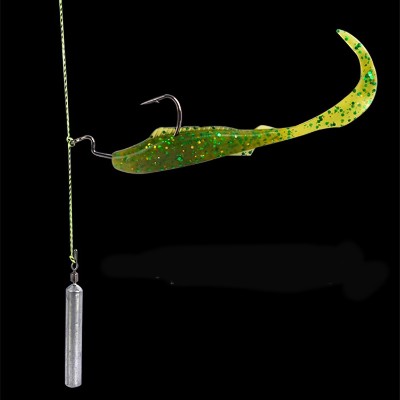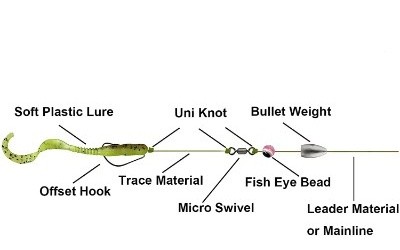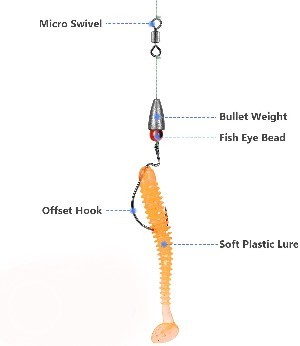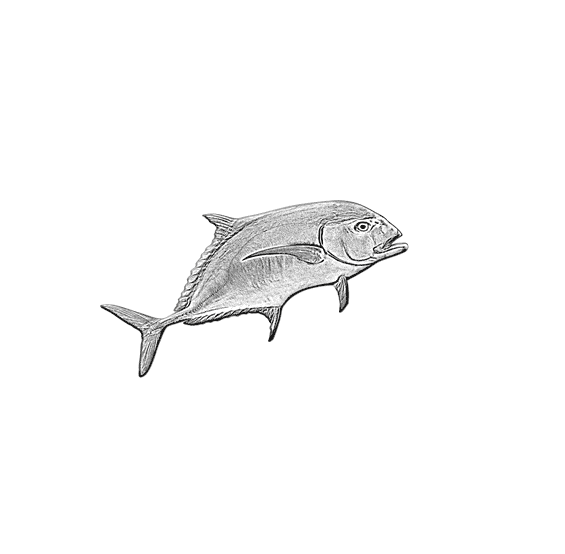
Also check out How to Drop Shot for Halibut and Flounder.
Are you ready to maximize your angling ability by adding the drop shot rig to your arsenal? Today, we’ll show you all you need to know to become a master in this successful fishing rigging method.
What is a Drop Shot Rig?

A drop shot rig is a straightforward setup for fishing at a preset depth from the bottom. The hook of a drop shot rig is connected directly to the line, but not at the terminal end. A length of leader below the hook remains, to which a sinker is tied at the terminal end.
The objective is for the weight to be on the bottom, with your bait suspended above it at the place where the fish are eating.
Why is Drop Shotting Effective?
Many fish are ferocious bottom eaters that locate the majority of their food on the seabed.
Small baitfish are up the majority of what these voracious fish consume, and unlike crabs, they aren’t directly on the seabed.
A drop shot rig allows an fisherman to put their bait right where the fish are hanging out for a meal. Whether the fish are actively feeding or not, a drop shot setup is tough to resist.
Drop Shot Rig Components:
A drop shot rig is made up of four common things, all of which you probably already have in your tackle box. For this setup, you’ll need line, a hook, bait, and a sinker.
Fishing Line:
What line you use is primarily a question of personal taste, and the conditions in which you are fishing should govern your choice. Some people like braided leaders, while others always use fluorocarbon leaders.
For most drop shot applications, anglers choose a 6-10 lbs. test fluorocarbon leader tied to braided mainline. If you’re fishing in heavy cover or in a rocky area, you may want to increase the strength of your leader that is tougher against abrasion.
Fluorocarbon leader line is often used since its characteristics make it virtually undetectable underwater.
Hooks:
The hooks you use should be chosen to match the species of fish you’re attempting to catch. Most fishermen use a size 1, 2, or 1/0 hook. Hooks larger than 1/0 are designated for larger fish.
There are several hooks designed specifically for drop shot fishing, but almost any hook will suffice. The most important element for a drop shot hook is an offset eye, which helps the hook to correctly stand out from the line.
Weights:
Drop shot weights come in a variety of sizes and shapes.
The most common weights are long cylindrical “finesse sinkers” that less affected by current while having a shape that lets you feel the bottom with through your line. Drop shot fishing using other shapes such as round, or teardrop sinkers is also popular.
Weights have traditionally been made of lead. These days, tungsten weights have become more and more common.
Tungsten is a conservation favorite since it is non-toxic and does not poison our rivers in the same way that lead does. Tungsten is tougher and weighs more than lead of the same size. These features make it easier to sense the weight on the bottom, while their smaller profile aids in throwing distance and accuracy.
Drop shot fishing is most commonly done with weights ranging from 1/8 to 1/2 ounces. The weight needs to be light enough so you can feel the bottom, but heavy enough for the sinker to quickly reach the bottom.
Bait:
What bait to should you use? Most people believe that soft plastics are the best drop shot bait.
You should choose a bait that resembles what the fish in the area are feeding on. Because the fish in the region will be more likely to attack a lure that looks like the food they are most accustomed to, selecting the proper color and design is always critical.
Drop Shot Fishing Rod and Reel:
The optimal drop shot rod and reel is a widely disputed topic, with each fisherman having their own opinion on the ideal configuration. While everyone’s preferences differ, a few general guidelines hold true.
Rods:
Drop shot rods can be either conventional and spinning rods. Most fishermen use spinning gear since they perform well with light equipment, and they’re easier to use in general.
The appropriate length of a fishing rod is determined by the type of fishing. A longer pole will aid with distance if you typically fish from shore. Shore fisherman like rods in the 7′ to 7’6″ length range.
A shorter rod in the 6’6″ to 6’8″ range may be desirable if you fish mostly from a boat and can fish with your line straight down from the pole. A 7′ model may be your best choice if you want a rod that can be used for both shore and boat fishing.
Most fishermen favor a medium-power rod. These rods have enough stiffness to set the hook on a large fish while being sensitive enough for the delicate approach needed for drop shot fishing.
A fast-action rod is typically optimal since the tip is flexible enough to give a natural motion to your bait while remaining rigid enough to pull a resistant fish out of cover. Extra-fast action rods feature a more stiff tip, which prevents anglers from giving a lifelike motion to their baits.
Reels:
Drop shot fishing is best done with smaller lightweight spinning reels, which have various advantages over heavier equipment or traditional setups. Drop shot fishing requires a 2500 to 4500 size reel.
You should select a lightweight reel that complements your rod. Also, a high gear ratio for a speedier retrieve is preferable.
How to Tie a Drop Shot Rig:
Now that you know everything you’ll need to catch monster fish on a drop shot rig, let’s go through how to tie one properly.
There are various ways to tie a hook to a drop shot, and you may choose one of them over the another. In my opinion, here’s the best way you can tie one:
How to Tie a Drop Shot Knot
1. Thread the line through the eye of the hook. The point of the hook must face up toward the rod and reel ( away from the sinker end of the line).
2. Pull about 7″ to 10″ of line through the toward the sinker end of the rig.
3. Pass the line over itself to form a loop above the hook.
4. Pass the hook through the loop 5 times. When you’ve done this, there should be 5 twists on each side of the hook.
5. Pull both ends of the line until everything tightens up.
6. Attach your drop shot weight to the rig’s tag end and start fishing!
How to Rig the Bait:
It’s simple to rig your bait on a drop shot rig, and depending on what the fish are searching for, any presentation could on any given day.
The nose hook, Wacky rig, Texas rig, and Carolina rig are the most common ways to rig a bait on a Drop Shot setup.
The bait is hooked through the center with the wacky rig. This permits the bait to float freely on both sides of the hook. This baiting style is good because it replicates the appearance of prey in distress which would be an easy meal for any hungry predator.
Another tried-and-true method is to hook the bait through the nose. Just pass the hook through the head of your bait, about ¼ inch into the bait.
Carolina Rig:

Hold the hook against your bait , so that the eye is with even with the head.
Find to the spot where the hook tip lies above the bait. This is where the hook will exit the bait.
Feed the point of your hook into the head of the bait, through the center. Push the hook tip into the the bait and push it up and out at the exit point.
Continue to push the hook through until the hook’s eye is against the head of the bait.
Texas Rig:

Push the hook shank through the bait exiting through the bottom, just past the head. After the hook is fed through up to the hook’s eye, push the tip into the bottom of the bait until the tip is just a tiny bit from exiting the top of the bait. When a fish bites the bait, it won’t initially feel the point of the hook, but once it really hits, the point will drive through the remainder of the soft plastic, and into the fish’s mouth.
